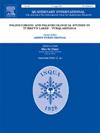语言学、考古学和遗传学证据表明,汉藏语系人口从中国北部向印度次大陆进行了多次由农业驱动的迁徙
IF 1.9
3区 地球科学
Q3 GEOGRAPHY, PHYSICAL
引用次数: 0
摘要
据推测,语系的传播是通过农业和人口结构的转变,即 "人口扩散",促使人口从农业起源中心向外迁移。然而,语系的地理起源往往与语言多样性最丰富的地方联系在一起。对于汉藏语系来说,这就产生了矛盾,因为印度东北部和尼泊尔的语言多样性最高,而黄河流域和长江流域的新石器时代作物驯化中心如今的语言多样性却很低。因此,要么汉藏语系起源于印度东北部,并通过其他方式传播;要么农耕民族从曾经语言多样的故土多次传播,随着民族向西传播,语言多样性得以保持或增加,但在故土却消失了。为了探索这两种假设,我们利用语言学、考古学和遗传学的证据,将中国黍类、栽培树木和农具(收割刀、肩锹)的现有数据与欧亚大陆西部的小麦和大麦数据进行了汇编。我们将起源于东亚的各种因素区分为北方文化传播和南方文化传播。在中亚,少数欧亚大陆东部元素(公元前 2500 年的黍和公元前一千年的锹)通过文化扩散向西传播,但主要不包括语系和基因系。在粟农的消解性扩散推动下,向南方的传播携带了更多的东方文化元素:黍、锹、发簪、收割刀、房屋平面图,以及重要的语言和遗传系。我们推测,大约从公元前 2500-2000 年开始,从东南高原经西藏东部和喜马拉雅山麓进行了一段脱胎换骨的扩散,将民族、语言和欧亚大陆东部的文化元素最终带到了克什米尔地区。我们的结论是,川藏-克什米尔和云南-阿萨姆这两条路线是这一时期连接中国北部和印度北部的最合理途径。本文章由计算机程序翻译,如有差异,请以英文原文为准。
Linguistic, archaeological and genetic evidence suggests multiple agriculture-driven migrations of Sino-Tibetan speakers from Northern China to the Indian subcontinent
The spread of language families is hypothesized to have occurred via agricultural and demographic transitions that drove populations outwards from agricultural centres of origin, “demic diffusion”. However, the geographical origins of language families are often tied to where greatest linguistic diversity is seen. For the Sino-Tibetan language family this creates a conflict, as maximal linguistic diversity lies in North-Eastern India and Nepal, whereas centres of Neolithic crop domestication in the Yellow and Yangtze River Basins have low linguistic diversity today. Therefore either Sino-Tibetan languages originated in North-Eastern India, and spread by means other than demic diffusion; or multiple diffusions of agriculturalists occurred from a once linguistically diverse homeland, in which linguistic diversity was maintained or increased as peoples spread westwards, but was lost in the homeland.
To explore these two hypotheses, using evidence from linguistics, archaeology and genetics, we compiled existing data on Chinese millets, cultivated trees, and agricultural tools (harvesting knives, shouldered spades) alongside data for wheat and barley from Western Eurasia. These elements were explored alongside existing information from genetic studies and for West Asian animal domesticates.
We differentiate a northern cultural and southern demic diffusion for various elements originating in East Asia. In Central Asia a small number of eastern Eurasian elements (millets by 2500 BC, spades by 1st millennium BC) spread west through pre-existing agricultural populations by cultural-diffusion, but significantly did not include language families nor genetic lineages. The southern dispersal driven by demic diffusion of millet farmers carried a more expansive range of eastern cultural elements; millets, spades, hairpins, harvesting knives, house plans, and significantly languages and genetic lineages. We hypothesize a period of demic diffusion beginning c.2500-2000 BC from the southeastern Plateau through Eastern Tibet and the Himalayan foothills, brought peoples, languages and Eastern Eurasian cultural elements eventually to the Kashmir region. We conclude two routes, the Sichuan–Tibet–Kashmir and Yunnan–Assam ones, are the most plausible pathways linking Northern China and Northern India during this period.
求助全文
通过发布文献求助,成功后即可免费获取论文全文。
去求助
来源期刊

Quaternary International
地学-地球科学综合
CiteScore
5.60
自引率
4.50%
发文量
336
审稿时长
3 months
期刊介绍:
Quaternary International is the official journal of the International Union for Quaternary Research. The objectives are to publish a high quality scientific journal under the auspices of the premier Quaternary association that reflects the interdisciplinary nature of INQUA and records recent advances in Quaternary science that appeal to a wide audience.
This series will encompass all the full spectrum of the physical and natural sciences that are commonly employed in solving Quaternary problems. The policy is to publish peer refereed collected research papers from symposia, workshops and meetings sponsored by INQUA. In addition, other organizations may request publication of their collected works pertaining to the Quaternary.
 求助内容:
求助内容: 应助结果提醒方式:
应助结果提醒方式:


